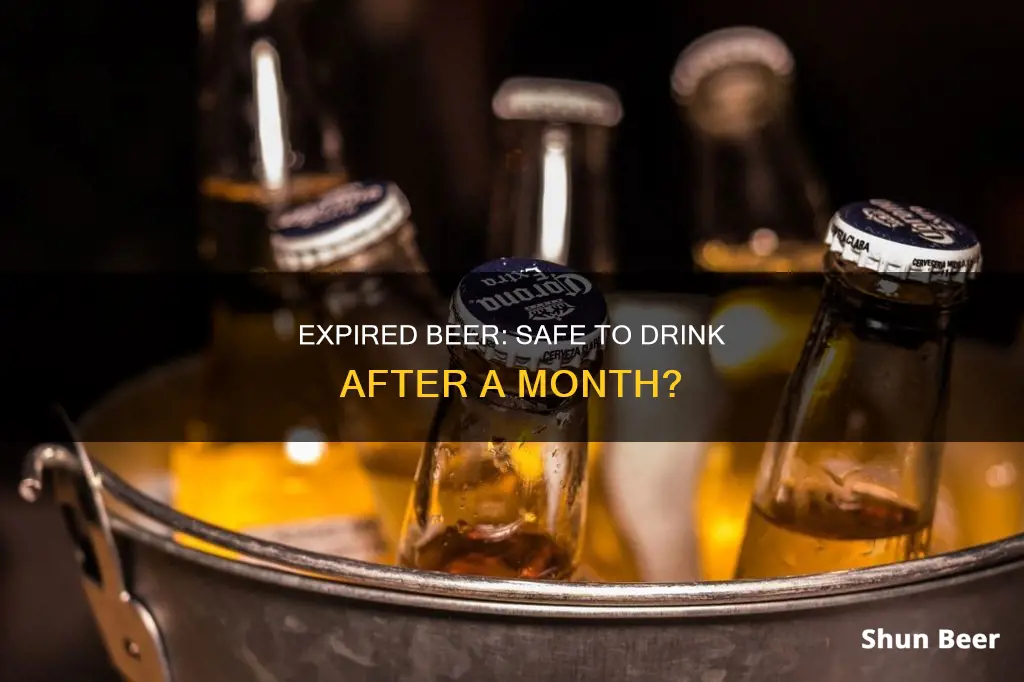
Beer does have an expiration date, but it doesn't go bad in the same way that food does. It's generally safe to drink beer that has passed its expiration date, but it may not taste very nice. Beer can go bad in several ways, including oxidation, exposure to UV light, microbial contamination, and temperature fluctuations. However, the alcohol content in beer acts as a preservative, preventing the growth of harmful microorganisms. So, while drinking expired beer may be unpleasant, it's usually not dangerous.
| Characteristics | Values |
|---|---|
| Is it safe to drink? | Yes, drinking expired beer is generally safe, but it may not taste very nice. |
| How does it taste? | Unpleasant, stale, cardboard-like, vinegary, sour, musty, metallic, mouldy, faded aroma, sulphuric, skunky |
| How does it smell? | Weak, sulphuric, skunky |
| Appearance | Hazy, cloudy, sediment, discoloured, dark |
| Carbonation and Head Retention | Flat, overly-carbonated, lack of foam, thin or watery, syrupy or thick |
| Storage | Store in a cool, dark place, away from sunlight, upright, with moderate humidity |
What You'll Learn

Beer doesn't 'expire' like milk
Beer doesn't expire in the same way that milk does. While it does have a shelf life and can go bad, it doesn't spoil in the same way as perishable foods and drinks. You won't find it turning sour, growing mould, or changing colour in the same way. Instead, what happens is a slow, steady deterioration in its taste and quality over time.
The fermentation process used in brewing, as well as its low pH level and alcohol content, make beer an unfriendly environment for microorganisms. Even if a beer sits on the shelf for years, as long as it’s sealed, it’s unlikely to make you sick. The worst thing that will happen is that the beer won't taste very nice.
Beer can go bad in several ways. When beer comes into contact with oxygen during the brewing process, packaging, or storage, it oxidises. This means that the oxygen reacts with the beer's chemical makeup, breaking down hop oils and other flavour compounds. This results in a cardboard-like or stale taste, a reduced aroma, and discolouration. Beer in clear or green bottles can also become "skunky" when exposed to UV light due to a photochemical reaction between UV light and hop compounds in the beer.
Commercial beers are well-pasteurised and filtered, but improper brewing practices, packaging errors, or poor storage conditions can lead to bacterial contamination. Unintended wild yeast infestations can also contaminate beer, especially in home brews or improperly sealed commercial brews. Contaminated beer can taste sour, musty, or metallic, and may become cloudy or develop unexpected sediment.
High temperatures accelerate chemical reactions, which break down the delicate flavour compounds in beer. On the other hand, freezing can cause the beer to expand, potentially breaking the container and introducing oxygen upon thawing. This can result in off-flavours, flat or overly fizzy beer, and a change in the beer's mouthfeel.
Over time, all beer will undergo chemical changes that alter its flavour, aroma, and mouthfeel. Aging causes the aromas and hop flavours to mellow, while the malt flavour becomes stronger. This is desirable for some people, but for others, it can mean a loss of the beer's intended profile.
Beer and pH Balance: Is It Safe to Drink Beer?
You may want to see also

It's safe to drink, but it might taste bad
It's safe to drink expired beer, but it might taste bad. While beer doesn't ""expire"" in the same way that milk does, it can lose its robust flavours and its quality will deteriorate over time. Beer can be spoiled by a number of factors, including oxidation, exposure to UV light, microbial contamination, and temperature fluctuations.
Oxidation occurs when beer comes into contact with oxygen during the brewing process, packaging, or storage. This process causes a chemical reaction that breaks down hop oils and other flavour compounds, resulting in off-flavours such as a cardboard-like or stale taste, and a reduction in aroma.
Beer in clear or green bottles is particularly susceptible to becoming ""skunky"" when exposed to UV light. This is due to a photochemical reaction between the UV light and hop compounds in the beer, producing a compound that gives off a distinctive skunky flavour and, according to one source, a corresponding sulfur-like smell.
Improper brewing practices, packaging errors, or poor storage conditions can lead to microbial contamination, resulting in bacterial or wild yeast infestations. Contaminated beer can have off-flavours such as sour, musty, or metallic tastes, and may become cloudy or develop unexpected sediment.
Temperature fluctuations can also affect beer quality. High temperatures accelerate chemical reactions that break down flavour compounds, while freezing can cause the beer to expand and introduce oxygen upon thawing. This can lead to off-flavours, affect carbonation levels, and impact the mouthfeel of the beer.
While drinking expired beer is generally safe, it's important to note that it may not always be pleasant. The taste, aroma, and mouthfeel can change, and the appearance of the beer may also be affected, with older beer potentially developing a hazy look or unexpected sedimentation.
To maintain optimal flavour and quality, it is recommended to store beer at a consistent temperature between 45 and 55°F (7 and 13°C) in a dark, cool place like a cellar or closet. Brown bottles and aluminium cans offer better protection against UV light compared to clear or green bottles.
Hospital Beer Drinking: Is it Allowed?
You may want to see also

Commercial beers are well-pasteurised and filtered
The process of pasteurisation involves heating beer to a certain temperature and holding it there for a defined amount of time before quickly cooling it. This can be done through the HTST (High Temperature Short Time) method, also known as Flash Pasteurisation, or Tunnel Pasteurisation, which was developed by Nicolas Appert in the 1800s. In the former method, beer is heated to a higher temperature (typically 162° F) for a shorter period of time (15-20 seconds). In the latter method, beer is heated to 140° F for about 30 minutes.
The choice between these two methods depends on various factors, including capital cost, equipment size, installation cost, utility cost, effectiveness, and the effect on the beer's taste. Flash Pasteurisation is generally more cost-effective and compact, while Tunnel Pasteurisation is considered more effective as the beer is bottled before pasteurisation, reducing the risk of downstream contamination.
In addition to pasteurisation, commercial beers also undergo filtration to remove microbes. This process, known as membrane filtration, employs very fine filters and is commonly used in large-volume plants that process a lot of beer.
Overall, while commercial beers may be safe to drink past their expiration date, it is important to consider that their taste and quality may degrade over time, especially if they are not stored properly.
Beer Commercials: No Drinking Allowed, Why?
You may want to see also

Beer is best stored in a cool, dark place
UV light, specifically ultraviolet rays, interacts with the hops in beer, creating a chemical reaction that produces a noxious chemical similar to what a skunk sprays. This is why beer often comes in brown bottles, as brown glass filters out UV light. Beer in green or clear bottles will be more susceptible to this process, known as "skunking". Beer stored in kegs or barrels will not skunk for a long time and can be stored for years if kept in the right conditions.
Warm temperatures will also cause serious damage to your beer. According to professionals, if beer lasts a year in the fridge, it will only last three days in the trunk of a hot car. Even if you're not planning on drinking the beer for a few weeks, it is highly recommended to store it in the fridge to lock in the flavour. If this isn't possible, store it in a cool, dark place, such as a pantry or a cupboard.
In addition to light and temperature, oxygen can also cause beer to spoil. This is because oxygen interacts with the compounds from malt, yeast, and hops, causing oxidation and a disappointing papery taste. Once a bottle or can of beer is opened, oxidation goes into hyperdrive, and if left out for too long, it will be left with a pretty sad version of the beverage.
To prevent spoilage, beer should be stored in a cool, dark place, preferably the refrigerator. If storing at room temperature, ensure that the beer is not exposed to sunlight. Additionally, beer should be stored upright to minimize oxidation, as this allows for less surface area of the liquid to come into contact with the air inside the bottle.
Beer Drinking: Heart Health Risks and Strains
You may want to see also

Beer can be used for other things if it's gone bad
While drinking expired beer is unlikely to make you sick, it may not taste very good. But that doesn't mean you have to throw it away! Here are some alternative uses for beer that's gone bad:
Cooking and Baking
Expired beer can be used in a variety of recipes, adding a unique flavour to your dishes. It can be used as a marinade for meat, helping to tenderise it and suppress the formation of carcinogenic compounds. You can also use it to make a tangy BBQ sauce, or bake a batch of beer bread. Beer is also a key ingredient in British fish and chips, adding a new twist to this classic dish.
Cleaning
Beer is an effective and natural cleaning agent, especially for wooden furniture, copper and cast iron cookware, and gold jewellery. It can also be used to remove stubborn stains from carpets and rugs. The natural acidity in beer helps to remove tarnish and grease build-up, leaving your pots and pans sparkling clean.
Gardening
Beer can be a helpful tool in the garden, attracting butterflies and destroying fungi. Spray it on patchy lawns to stimulate plant growth and get rid of bald spots. It can also be used as a slug, snail, or earwig trap, luring these pests to their demise.
Beauty and Personal Care
Beer is rich in nutrients, vitamins, and yeast, making it an effective ingredient in hair and skin care routines. Washing your hair with flat beer can add shine and body, while a beer face mask can help balance skin pH levels and tighten pores. For tired feet, a basin of warm water and stale beer can soften hard skin and calluses, leaving your feet feeling refreshed.
Drinking Beer and Driving in West Virginia
You may want to see also
Frequently asked questions
Yes, drinking 1-month-expired beer is generally safe. Beer doesn't spoil in the same way as perishable foods like milk. It won't turn mouldy or grow harmful bacteria that can make you sick.
The taste and quality of expired beer will deteriorate over time. It may develop off-flavours and aromas, such as a cardboard-like or stale taste, or a vinegary or metallic taste. The beer may also appear cloudy or develop sediment.
To prolong the shelf life of your beer, store it in a cool, dark place, such as a refrigerator or cellar, and avoid exposure to direct sunlight or fluorescent lights. Keep the beer upright and try to maintain a consistent temperature to prevent rapid aging and degradation.







